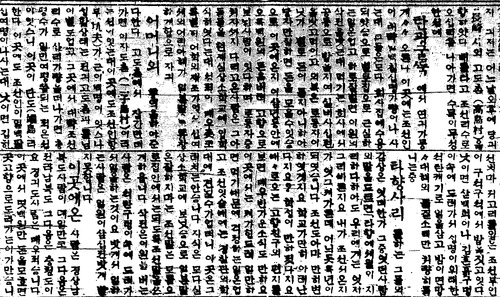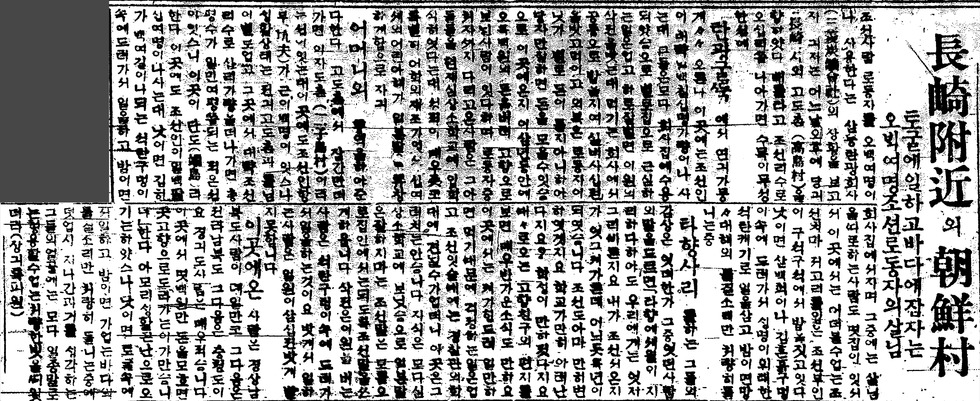Korean Village Near Nagasaki
June 8, 1922 (Taisho 11)
(Dong-a Ilbo, June 8, 1922)
Contemporary conditions in Hashima are described in a report filed by a correspondent of the Dong-a Ilbo newspaper. The article provides detailed descriptions of Korean workers employed in Hashima and contains the statement, “Many of the workers return home after saving several hundred yen.”
Dong-a Ilbo
June 8, 1922 [Taisho 11]
Authorship: Materials provided by National Diet Library
Dong-a Ilbo: Newspaper
- Author
Page 1
Working in Caves and Sleeping by the Sea
The Lives of More than 500 Korean Workers
This reporter headed out one afternoon to Takashima Village in Nagasaki City to observe the conditions in the Mitsubishi Mining Company where about 500 Koreans are employed. I boarded a ship and sailed out to a distance of about 50 ri in the Korean measurement of distance [ri = 400 meters]. What first entered my sight were the plumes of smoke rising from the coalmines of this green and verdant island. About 170 Koreans live on this island. Housing is not a problem as all are accommodated in company housing. One good day of work earns 2 yen in wages. Food is provided by the company at a cost of 40 sen per day and clothing is not a major expense as all are laborers. An industrious worker can even manage to save some money. It is said that after working here for two or three years, some workers are able to save about 500 – 600 yen, which they have sent back home. Among the workers that have brought their wives and children with them, some of the sons have been enrolled in primary school. The children have earned high marks and are particularly gifted in languages. A child just over ten years old was said to be speaking fluent Japanese and translating for his mother. Advancing a little further out from Takashima Village, one arrives at an island known as Futago Island where nearly 200 Korean miners live. The standard of living is the same as that in Takashima Village. A further 10 ri out in Korean measurement lies a small island that is only about 10,000 tsubo in total area. A little more than 180 Korean workers live and work here. During the day, they toil in coalmine shafts that are a little more than about 100 hiro in depth [hiro = the distance between outstretched arms], and at night they return to their company housing to sleep. Several families live in their own houses that are situated apart from company housing. In these homes, Korean women dressed in chima jeogori are seen preparing food. During the day, [the men] work at depths of 300 shaku [90.9 meters] mining for coal in dangerous mineshafts, and nights are spent listening to the lonesome sound of the vast ocean. What goes through the minds of these workers living so far from home? The mineworkers I spoke to shared these thoughts. “Some say that living in foreign lands is unbearable. But for us, the time here passes very quickly. Although six years have already passed, it’s as though I arrived here a few days ago. Korea has probably changed a lot. Many schools have been built and there are many students now. When letters arrive from friends back home, they contain really happy news. If you work hard here, food is not a worry. Back in Korea, I could not stand the abuse by policemen. But here, abuse does not happen. All the children are enrolled in primary school. They speak good Japanese but their Korean is poor. So, we try to speak as much as possible in Korean at home. Those who earn 2 yen per day are those who work inside the mineshafts. Those who work outside earn only 1.20 – 1.30 yen.”
The largest number of workers here are from South and North Gyeongsang Provinces. The next largest group is from South and North Jeolla Provinces, followed by Chungcheong Province. There is almost no one here from Gyeonngi Province. They say, “Many of the workers return home after saving several hundred yen.” These are people who came here because life back at home was difficult. Nevertheless, an indescribable ray of sadness covers the faces of these men who work in mineshafts during the day and spend the evenings reminiscing about the past as the waves repeat their gloomy rhythm.
(Nagasaki Correspondent)
(June 8, 1922 [Taisho 11])



